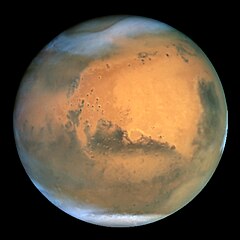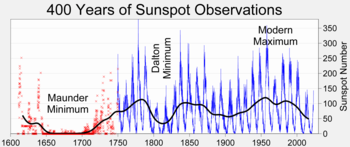| Revision as of 21:46, 19 February 2007 editWilliam M. Connolley (talk | contribs)Autopatrolled, Extended confirmed users, Pending changes reviewers, Rollbackers66,041 edits rm: Some researchers propose that the apparent Mars warming trend (based on preliminary data available from rovers) is attributable to solar variation - this has no source← Previous edit | Revision as of 22:12, 19 February 2007 edit undoRameses (talk | contribs)600 edits Removed material unrelated to MarsNext edit → | ||
| Line 35: | Line 35: | ||
| For three Mars summers in a row, Mars' southern polar cap has shrunk from the previous year's size; this suggests that at least some parts of ] are experiencing warming. <ref></ref>. | For three Mars summers in a row, Mars' southern polar cap has shrunk from the previous year's size; this suggests that at least some parts of ] are experiencing warming. <ref></ref>. | ||
| ⚫ | This mat be explained by a ] study at the ] in ], which concluded that "the Sun is burning more brightly than at any time during the past 1,000 years" and attributed recent global climate change on earth to the combined effect of greenhouse gases and increase in solar activity.<ref></ref> | ||
| Although a recent article in ''Nature'' (2006) reported that there was no change in solar radiation in the last 30 years.<ref></ref> | |||
| ⚫ | This |
||
| The present level of solar activity is historically high. Solanki ''et al.'' (2004) suggest that solar activity for the last 60 to 70 years may be at its highest level in 8,000 years; Muscheler ''et al.'' disagree, suggesting that other comparably high levels of activity have occurred several times in the last few thousand years.<ref>Muscheler et.al., ], , 2005. Retrieved February 11, 2007.</ref> Solanki concluded based on their analysis that there is a 92% probability that solar activity will decrease over the next 50 years. | The present level of solar activity is historically high. Solanki ''et al.'' (2004) suggest that solar activity for the last 60 to 70 years may be at its highest level in 8,000 years; Muscheler ''et al.'' disagree, suggesting that other comparably high levels of activity have occurred several times in the last few thousand years.<ref>Muscheler et.al., ], , 2005. Retrieved February 11, 2007.</ref> Solanki concluded based on their analysis that there is a 92% probability that solar activity will decrease over the next 50 years. | ||
Revision as of 22:12, 19 February 2007
This article is being considered for deletion in accordance with Misplaced Pages's deletion policy.
You may share your thoughts on the matter at this article's entry on the Articles for deletion page.
Please improve the article if possible, but the article must not be blanked, and this notice must not be removed, until the discussion is closed. For more information, particularly on merging or moving the article during the discussion, read the guide to deletion.
Steps to list an article for deletion: {{subst:afd}} • Preloaded debate OR {{subst:afd2|pg=Martian global warming|cat=|text=}} ~~~~ • {{subst:afd3|pg=Martian global warming}} log
| It has been suggested that this article be merged into Mars. (Discuss) Proposed since February 2007. |
| It has been suggested that this article be merged into Climate of Mars. (Discuss) Proposed since February 2007. |
 Mars as seen by the Hubble Space Telescope Mars as seen by the Hubble Space Telescope | |||||||||
| Designations | |||||||||
|---|---|---|---|---|---|---|---|---|---|
| Adjectives | Martian | ||||||||
| Symbol | |||||||||
| Physical characteristics | |||||||||
| Albedo | 0.15 | ||||||||
| |||||||||
| Atmosphere | |||||||||
| Surface pressure | 0.7–0.9 kPa | ||||||||
| Composition by volume | 95.72% Carbon dioxide 2.7% Nitrogen 1.6% Argon 0.2% Oxygen 0.07% Carbon monoxide 0.03% Water vapor 0.01% Nitric oxide 2.5 ppm Neon 300 ppb Krypton 80 ppb Xenon 30 ppb Ozone 10 ppb Methane | ||||||||
For three Mars summers in a row, Mars' southern polar cap has shrunk from the previous year's size; this suggests that at least some parts of Mars are experiencing warming. .
This mat be explained by a 2004 study at the Max Planck Institute for Solar System Research in Germany, which concluded that "the Sun is burning more brightly than at any time during the past 1,000 years" and attributed recent global climate change on earth to the combined effect of greenhouse gases and increase in solar activity.
The present level of solar activity is historically high. Solanki et al. (2004) suggest that solar activity for the last 60 to 70 years may be at its highest level in 8,000 years; Muscheler et al. disagree, suggesting that other comparably high levels of activity have occurred several times in the last few thousand years. Solanki concluded based on their analysis that there is a 92% probability that solar activity will decrease over the next 50 years.





See also
References
- Orbiter's Long Life Helps Scientists Track Changes on Mars
- The truth about global warming - it's the Sun that's to blame.
- Muscheler et.al., Nature, How unusual is today's solar activity?, 2005. Retrieved February 11, 2007.
External links
- Mars could be undergoing major global warming
- Mars Ski Report: Snow is Hard, Dense and Disappearing
- Mars Global Surveyor MOC2-1151 Release
- Global warming on Mars?
- Prisonplanet.com:SUV's on Jupiter?
- Images of melting ice cap: Evidence for Recent Climate Change on Mars